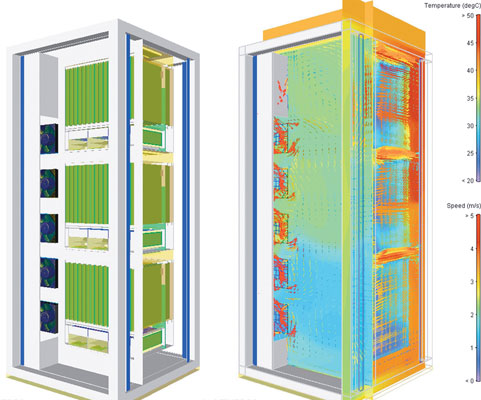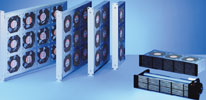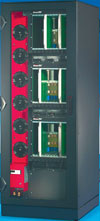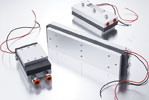
In order to guarantee the operating safety and reliability of a plant or a system, it is necessary to dissipate the heat which is generated through the active electronic components assembled in a cabinet. In the past, due to the relatively low level of performance losses of the components, this could be achieved through natural convection or through the installation of simple fans.
However, in the last 10 to 15 years the installation density has increased considerably, the components are more and more efficient and the resulting performance losses are becoming larger and larger. Clever cooling concepts with filter fans, fan plug-in units, regulated air flow up to air/air heat exchangers and cooling units with compressors have become necessary to cool cabinets efficiently.
With increasing performance losses of components in electronic plug-in units the conventional air cooling reaches its limits more and more often. From approximately 8 to 10 kW performance losses, the available air volume of a cabinet is no longer sufficient for its cooling. An alternative is air/water cooling. Considerably more heat can be dissipated due to the water's higher density. Increasingly, the option to cool individual components or subracks is in the focus; thereby the heat is dissipated where it is generated, for instance at the location of a processor. The cooling concept of a complete cabinet can be supported sensibly and the entire cooling performance can be improved.
As much cooling as necessary
In most scenarios the cooling is governed by two criteria: the level of the performance loss and the location. That is why in rooms with climate control, mostly open or air cooled cabinets are used. Depending on the performance loss additional fans, such as fan chassis, blowers, pagoda fans, filter fans or air/air heat exchangers, will be added to the fans already integrated into the components. Depending on the type of the supporting air cooling, the cabinets have to be partially or totally closed, as with filter fans and air/air heat exchangers. When the ambient temperature is not sufficiently cool to keep the temperature at the required level, cooling is carried out either with cooling units or with water. In some cases Peltier elements are used. The issues governing when and why particular cooling components are suitable, are explained here.
Natural convection: without forced ventilation
The utilisation of natural convection in a closed or open cabinet is the least expensive method to expel heat. In a closed cabinet it can be used effectively only if the energy can be dissipated via the cabinet panels to the surrounding air (heat conduction). Ambient temperatures have to be significantly below the required internal server cabinet temperatures in this case.

The location of the server cabinet, ie free standing or side-by-side in a corner of a room, must allow for the required internal temperature. In this case the energy balance should be checked along the specifications of the cabinet manufacturer. In case of doubt the DIN VDE 0660 specification, Part 500 or Part 507, should be consulted, which contains an overview of such arrangements as well as calculation instructions.
With open cabinets it also has to be taken into account that the air can pass through the cabinet unhindered. Experience shows that cooling concepts of this type realise a cooling performance of approximately 600 W with closed cabinets. With the use of fans integrated into the assemblies, the cooling performance can rise to approximately 10 kW.
Fan trays: power in rows
These are used below the subracks in order to improve the natural convection, or even enable it where the air resistance of the installed components is too large for natural convection. They can also be used for air circulation in a cabinet. Combined with a pagoda fan and air intake at the bottom of the cabinet, the cooling performance can be increased.

Here, too, the ambient temperature has to lie clearly below the stipulated cabinet temperature and the positioning of the cabinet must be taken into account for the energy balance. With open cabinets it has to be ensured that the air can pass freely through the cabinet. Distinct advantages in the cooling performance are only achieved in climate controlled rooms. A cooling advantage compared to natural convection can only be achieved with open cabinets and can reach as much as 2 kW.
Filter fans: the air volume is vital
Filter fans represent affordable and effective climate control for server cabinets. However, they are only hesitantly deployed as in most cases the air volume on offer is not sufficient to expel the heat loss. The air circulated with filter fans has to be adapted to the air volume required by the components. The internal assembly of a cabinet has to guarantee the unhindered circulation of the air which is supplied through the filter. Therefore as a rule, air intakes and outlets should be arranged diagonally over the entire height of the server cabinet. Distinct cooling advantages here, too, are only achieved in climate controlled rooms. Filter fans presently on offer on the market operate with air volumes of 20 m³/h and 700 m³/h. Meaning, at 25 K temperature difference a theoretical performance loss of up to 5,7 kW can be dissipated. Experience shows that filter fans in cabinets are used for performance losses of up to 2 kW.
Air/air heat exchanger (LLWT): often for outside use
LLWTs are used in closed cabinets without affecting their IP protection. The operating principle is based on two air cycles which are separated from each other, each carrying heat. The internal cycle circulates the internal air of the cabinet and transports the energy taken from it to the heat exchanger, while the outer cycle transports the ambient air past the heat exchanger and thereby takes the energy from it.
Depending on how the two air cycles pass each other near the heat exchanger, we speak of a direct flow LLWT if the two air cycles flow parallel to each other in the same direction and of a contra flow LLWT, if the air flows parallel but the cycles flow in opposite directions. When the air streams flow at an angle of 90°, we talk of a cross flow heat exchanger. The performance of a LLWT is stated in Watts per Kelvin.
LLWT utilisation in cabinets occurs largely in outdoor applications. According to the manufacturers, the standard LLWTs offered to the market have a heat capacity of between 15 and 150 W/K. This means that up to 3750 W can be dealt with at a temperature difference of 25 K.
Air/water heat exchanger (LWWT): the quality of the water is important
LWWTs, too, are used in closed cabinets, without influencing the IP protection. The operating principle is based on two cycles which are separated from each other. The inner air cycle circulates the air inside the cabinet and the heat taken away is transported internally to the heat exchanger. The outer cycle transports the heat with a fluid (mostly water) to a chiller (cold water replacement). For the operation of a LWWT, enough water of the quality determined by the manufacturer has to be available. The LWWTs presently available on the market for the cabinet sector offer cooling performance up to 30 kW.
Cooling units: a compressor provides coldness and noise
A cooling unit for a cabinet is a compressor whose task it is to transport the heat from the inside of the cabinet to the outside and thereby to keep the internal temperature at the required level and within the hysteresis margins. The fan responsible for the inner cycle circulates the air permanently and the temperature is monitored via a thermostat. Once the required cabinet temperature is reached, the compressor and the fan of the outer cycle are switched on. This activates the cooling cycle until the temperature is lowered by the hysteresis value of the thermostat.
A cooling unit should only be operated in a closed and sealed cabinet; otherwise part of its performance would have to be used to de-humidify the cabinet instead of cooling it. Depending on the humidity and the temperature difference, several litres of condensed water would be produced per hour. The selection of a cooling unit should be based on the maximum performance loss of a cabinet and the operating level desired.
For this, the cooling performance hysteresis of each particular cooling unit should be observed. Should the performance loss be too near the activation limit of the cooling unit it would switch on too often, which would reduce the compressor's life expectancy or it would run permanently, which would lead to increased condensation.
If a cooling unit is used the air flow in a cabinet has to be arranged so that no air short circuits occur, whereby the recently cooled air would be extracted almost immediately instead of cooling the components. If an external temperature sensor should then be positioned near the no longer cooled component, the cooling unit would run permanently and could even ice up in certain circumstances. It also has to be observed that the air intake and outlet of the cooling unit is accessible at all times and is not afflicted with air resistances; otherwise this, too, could cause ice to form on the cooling unit. The cooling performances of cooling units can vary considerable from approximately 20 W to over 4 kW.
Peltier elements (PE): cooling and warming
Peltier elements are thermo-electrical elements transporting heat from one side to the other with direct current and can be used for cooling and warming. The principle of operation was discovered in 1834. Direct current is required for the use of a Peltier element; if the current has a ripple effect, the typical values are reduced. In order for a Peltier element to transport heat, it has to be observed that on both sides, warm and cold, heat energy can be taken in and also expelled. There are several ways in which a Peltier element can be operated:
* Air-air: the heat energy of the air, which flows past the cold side of the PE is taken up by the PE and transported to the hot side, where it will be expelled via the air. Both sides of the PE are usually equipped with fans.
* Air-water: The heat energy of the air, which flows past the cold side of the PE is taken up by the PE and transported to the hot side, where it is led away by a fluid. The cold side of the PE is usually equipped with a fan; the hot side is equipped with water connections.
* Direct-air: The heat energy of the element that requires cooling is taken up via the cold side of the PE and led to the hot side, where it is expelled with air. The hot side of the PE is usually equipped with a fan.
* Direct-water: The heat energy of the element which requires cooling is taken up directly via the cold side of the PE and transported to the hot side, where it is led away with the fluid. The hot side of the PE is equipped with water connections.
* Water-air: The heat energy of the fluid, which flows past the cold side of the PE is taken up by the PE and led to the hot side, where it is transported via air. The cold side of the PE is equipped with water connections; the hot side is usually equipped with a fan.
* Water-water: The heat energy of the fluid, which flows past the cold side of the PE, is taken up by the PE and transported to the hot side, where it is transported by the fluid. Both sides of the PE are equipped with water connections.

In certain cases Peltier elements are cooled by pure convection. However, most common is the forced air cooling with a fan. Typical applications of Peltier elements are for instance cooling of laser diodes and sensors, CCD chips in high value cameras, mini fridges in professional areas, medical thermocyclers, applications in the automotive industry and also the cooling of individual components in an electronics cabinet. Should cooling of selective points be required, the manufacturers' specifications have to be observed very strictly to ensure sufficient contact. Depending on the temperature difference, performances to 350 W are possible as standard, with efficient modules achieving a cooling capacity up to 14 W/cm². Peltier elements with DT up to 75 K or temperature levels up to 150°C are possible.

Heat pipes: directional cooling
A heat pipe is a hermetically sealed, unpowered system filled with a fluid. The type of fluid and the pressure in the system depends on the required temperature level. Liquid gases (helium, nitrogen), alcohols, water or even metals (mercury, sodium or lithium) can be used as the fluid, with water being most widely used in cabinets. The pressure in the system is selected so that the water has a precisely fixed evaporation temperature (boiling point). For example if the pressure is set at approximately 320 hPa (low pressure), the water will evaporate at a temperature of approximately 70°C. If the pressure is reduced to approximately 200 hPa an evaporation temperature of approximately 60°C will be achieved. That way the operating level of the system can be determined.
A heat pipe is divided into two areas. The first area is the heat transfer area for the heat source. Here the fluid, for instance water, is evaporated through heat influx in the heat zone and then flows into the cooling zone. The second area is the heat transference surface for the heat reduction, where the steam gives off heat, condenses and flows back to the heat zone. The use of a heat pipe is best for designated, directional cooling as it is required for instance for processors or graphic chips. The cooling of a room following this principle is less effective at present and very cumbersome. This performance, which can be transferred with a heat pipe, depends on the operating level of the systems and the temperature difference. In the electronics area and for the direct cooling of processors the heat flux can reach approximately 40 W/cm².
Vortex pipes: chemically neutral cooling
Vortex pipes operate following the principle of the separation of a strongly swirling mass flow into a warm and a cold part-flow. These two part-flows take up two different layers in the so-called vortex pipe; they can thereby be transported separately from each other. That way the warm layer exits at one end of the pipe and the cold layer at the other. The cold air flow can be directed very accurately, is clean and does not cause any side effects, which can often occur with cooling fluids. Professional vortex pipes can reach temperatures from -45°C to +110°C. Everywhere where directional and chemically clean neutral cooling is demanded and at the same time enough compressed air is available, vortex pipes are favoured. The cooling range lies between 40 W and approximately 3 kW. Unfortunately this type of cooling generates a relatively high noise level, over 80 dB(A).
A combination for effective cooling concepts
The individual cooling components always have to be adapted to the required total result and the other components used. This means that for example with forced air cooling, the fans used must not interfere with each other. If for instance several fans are switched on together, it has to be observed that their hysteresis curves are aligned with each other and none of them act as a break.
If cooling units are used for a cabinet the air flow of the cooling unit has to be adapted to the air flow of the installations. A negative example is a cooling unit hung on the door which can only circulate the air in the front part of the cabinet. The servers in the cabinet, however, take in the air at the front and expel it at the rear.
The cooling performance of the unit always has to be adjusted to the total performance loss of the cabinet. A negative example: the fan should expel a performance loss of 4 kW, but the cooling unit has been arranged for only 3,5 kW. A similar problem arises with most combined cooling solutions. For example when a heat pipe is used, suitable ventilation has to be guaranteed, if performance and effectiveness demand it. The efficiency of a Peltier element, too, stands and falls with specifically adapted air cooling.
Simulation instead of try-outs
Often very helpful and almost indispensable is the thermal simulation of the heat generation and the heat flow in a cabinet with suitable software. The reasons for this are manifold.
In recent years there has been a rapid increase in the assembly density of electronic components with regard to their performance losses, as the plant operators pay the rent for the so-called footprint. The heat problem becomes more and more complicated when more and more air cooled cabinets are located in a room. In such cases and in the hands of an experienced specialist the simulation software delivers results which on the one hand guarantee the optimum cooling of a cabinet and on the other hand the best utilisation of the surface area of a computer centre. A professional development of a cabinet therefore requires that a specialist be involved in the planning phase, who advises the developers and carries out the necessary calculations.
| Tel: | +27 11 608 3001 |
| Email: | [email protected] |
| www: | www.actum.co.za |
| Articles: | More information and articles about Actum |

© Technews Publishing (Pty) Ltd | All Rights Reserved